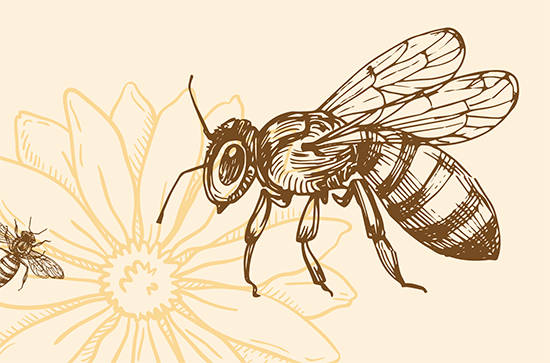
December 2020- January 2021
Passing the Faith
------------------
|





Hairy, Six-Footed Honey-Makers, Part One
By Brenda and Bill Evans
One thing friends do is prod you to pay attention to things you never paid attention to before. Our friend Chuck Hennecke drew our attention to six-footed honey bees. He and another friend, Warren Rogers, are beekeepers, more specifically, keepers of Apis mellifera, the Latin name botanist and zoologist Carl Linnaeus gave these honey-bearers in 1758. Three years later, he preferred the name Apis mellifica, honey-maker.
Chuck got acquainted with honey bees when he was young and got stung mowing the lawn around his father’s beehives. About ten years ago, Chuck became better acquainted. He heard a West Virginia state inspector apiarist say, “If somebody tells you he knows all about honey bees, he’s lying, and he’ll tell you another one.” That amused Chuck, but also drew him in, challenged him to know more, to raise the hairy six-footed insects, help them thrive and make honey. He bought a colony of bees and a ten-frame hive, then used the boxy hive as a model to build more.
Chuck and Warren’s fathers were beekeepers, but both vowed they would never be. Warren now has nine colonies and is the vice president of the Northeast Kentucky Beekeepers Association. Chuck has 17 colonies and is the apiarist for the association where he tends five more.
What does it take to be a good beekeeper? A lot. Chuck and Warren started with curiosity, liking a challenge, and a passion to do battle. Chuck likes figuring things out, solving problems, learning what to do to help the inch-long gold and brown honey-makers thrive. Warren says, “You have to love them, too, so you’ll fight to keep them alive and productive.”
We visited Chuck’s workshop and honey house in mid-summer. He has built a 4- by 6-foot oak observation hive with glass on each side. There, we put our noses to the glass and watched thousands of worker bees and one large queen hard at their jobs, moving over the honeycombs, making and storing honey, rearing their young. It was fascinating. Later that day in the honey house, we watched Chuck and Warren extract honey. July in Kentucky is honey harvest time.
From our friends, we’ve learned a lot about hairy, six-footed honey-makers. To begin with, honey bees are not native to North America. European settlers first brought them to coastal Virginia in 1622. By 1650, hives were prospering in Massachusetts and other places along the East Coast. They moved into the Ohio Valley around 1670 then spread across the Mississippi, the Plains, and on to California by 1853. Thomas Jefferson wrote in 1783 that Native Americans called the honey bee “the white man’s fly.”

Honey is an ancient product. In his Deuteronomy 32 song, Moses extolled the Lord for his myriad blessings, among them honey drawn from the crevices of unproductive desert rocks where colonies of wild honey bees had laid down their honey for God’s people. There, and in about 60 other places, the Bible mentions honey as a valuable food; bartering commodity; and symbol of abundance, wisdom, even the Word itself. Ten biblical characters talk about honey.
Honey bees are most memorably highlighted in Judges 4 and 5 when the “honey bee” judge Deborah (honey bee is the meaning of her Hebrew name) called out Barak, at worst for his cowardice, at best for his unwillingness to go to battle without her. Deborah promised to go but warned Barak he would get no glory for the victory over the Canaanites Jabin and Sisera. Glory would go to a woman, she said. And it did, first to Deborah, the honey bee, and then to Jael, that fierce, nomadic, tent-dwelling, non-Hebrew woman who drove a tent peg all the way through Sisera’s temple and into the ground. The British poet Tennyson called Deborah “that great dame of Lapidoth,” and great that honey bee was.
As for honey bees themselves, what’s so intriguing? One thing is their tight organization within a colony. Zoologists call them eusocial because of their advanced division of duties, functions, and lines of work. As a rule, a colony has one queen, 20 to 30 thousand workers, and several thousand drones. Colonies can go as high as 40 to 60 thousand.
The queen’s sole function is to be an egg-laying machine, as many as 2,000 eggs (or her weight) a day. Worker bees are female, non-reproducing, and are divided into castes. Young workers, three to ten days old, are called nurse bees. They feed the infant larva royal jelly, a thick, sticky, pale yellow liquid secreted from glands in the heads of nurse bees. This bee milk, as it is called, is water, proteins, sugars, fats, and vitamins.
If a larva feeds only on royal jelly, it goes on to pupate and grow to maturity as a queen in about 16 days. The queen continues to be fed only royal jelly until her ouster or death in about three years. But nurse bees briefly feed other larvae royal jelly, and later a mixture of nectar and pollen called bee bread. Those pupate emerge as workers or drones. Workers emerge fully developed in about 20 days and drones in about 24 days.
Older workers do the “other” work of the colony. Though they can’t reproduce, workers control most of what goes on. They feed and tend the queen, clean, feed drones and larvae, make and store honey. As sticklers for a good place to live and work, they are the architects of the hexagonal honeycombs, guardians of the hive, and undertakers for the dead. In winter, they keep the hive from freezing by forming a tight ball of bees around the queen and “shivering” to create heat. In summer, they fan their wings to cool the hive.
Workers also are the foragers who fly out to collect pollen, nectar, water, and plant resins. They also are the only bees in the colony who can sting. If they do, they die because their stinger gets stuck in the victim and pulls out the bee’s guts. Most workers live only about four weeks.
Drones, the largest bees in the colony, are the only males. They make up about 10% of the colony’s population. They eat a lot, but do not work, sting, or gather nectar and pollen. Their primary role is to mate with a queen to propagate the colony then quickly die. Unmating drones get kicked out of the colony after about 90 days. New ones are raised each spring.
As for anatomy, a honey bee’s three-part body is hairy all over. As workers brush against flowers and trees, their hairs spread pollen to other plants and also gather it for their hive. Their six feet and legs “groom” or gather the pollen from the hairs and move it to a joint in their hind legs that presses it into pellets. The pellets are then stored in a pollen basket on the outside of the hind lower leg and delivered to the hive.
Honey bees’ brains are the size of a sesame seed. They have no ears, but their antennae provide a kind of hearing—the detection of vibrations—used inside the hive, but especially outside the hive in bee dances that help direct foraging workers to nectar and pollen. Workers perform at least two dances, the waggle and the round dance. The waggle communicates direction, distance, and quality of the food source. The round dance indicates food is very near.
Honey bees also have a sense of touch, taste, and smell. Scientists believe the sense of smell is better than a human’s. Their taste receptors can discern which nectars are sweetest. Their mouth parts or proboscis form a sucking tube and tongue. Their eyes can detect color, helping them orient in the field to collect nectar, pollen, resins, and water. Painting hives different colors can help bees find their own hive.
Honey bees are amazing insects. Somewhere in His creative acts, the Lord fashioned the hairy, six-footed honey bee. We think He said, “They are very good.”
(We will go into Chuck’s honey house and watch a honey harvest in Hairy, Six-Footed Honey-Makers: Part 2.)
About the Writer: Bill and Brenda Evans live and enjoy their friends’ honey in Ashland, Kentucky. You may contact them at beejayevans@windstream.net.
|
|

